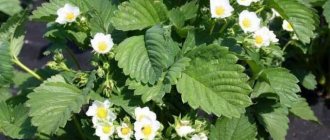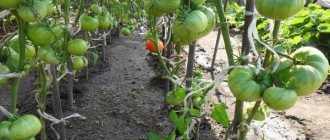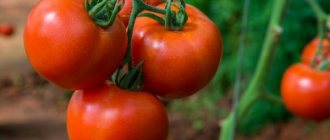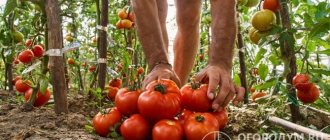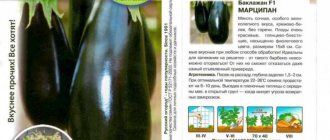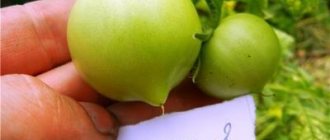Eggplant Bibo F1 is a promising hybrid that farmers have excellent reviews of. The vegetable has significant yields and strong resistance to adverse weather. Cultivation is carried out according to agricultural technology for annual crops; the plant is grown under film, glass coverings, and in open beds.
| Origin | Landing location | Ripening period | Fruit color | Fruit weight | Fruit shape |
| Hybrid | Greenhouse | Early | White | 190-300 g. | Cylindrical |
Characteristics of eggplant Bibo F1
Bibo's characteristics are as follows:
- height - small, no more than 70 centimeters;
- bushiness is moderate, the eggplant does not grow too wide;
- yield is average, about five kilograms per square meter;
- The harvest time is early, the fruits ripen in ninety days.
Bibo's fruits are oblong, of average length for an eggplant.
Bibos would be absolutely indistinguishable from others for a non-professional if not for their specific coloring - the fruits are pure white, their skin is glossy and thin. Beneath it is white flesh, devoid of cavities, without bitterness.
Description and characteristics of the variety
Eggplant Bibo F1 is produced by a Dutch agricultural company that developed the hybrid in 2006. The name of the company from the Netherlands is Monsanto Holland. In Russia, seed material is represented by the “Partner” group. Since 2008, the variety has been included in the State Register. The growing season is short, the hybrid is early ripening. The first fruits are harvested 90-98 days after germination.
The fruits have a special feature - they are pearl-colored and evenly shaped. The taste is classic without bitterness.
Features of the fruit:
- average weight 190-300 g;
- length 15-19 cm;
- diameter 6-7 cm;
- exterior color is white;
- glossy skin;
- oval, elongated shape;
- The pulp is snow-white, elastic texture.
Eggplants are marinated, fried, stewed. They are served with sour cream or tomato sauce. For the winter, they are used to prepare caviar, assorted dishes, and pickles.
The crop is intended for universal cultivation (in greenhouses, greenhouses, in unprotected areas). This hybrid is characterized as medium-sized. The height of the plant reaches 60-65 cm. The shape of the crown is semi-spreading. The leaf blades are small. Edge with slight wavy.
Advantages and disadvantages
The main advantages of Bibo are as follows:
- high commercial characteristics - white eggplants look original, therefore the chance of selling them increases, plus the products are of high quality, most of the fruits look presentable and suitable for sale;
- early ripeness - Bibo is harvested at the end of summer, which is quite convenient;
- solid yield - not all varieties produce five kilograms;
- resistance - Bibo tolerates transportation well, and is also immune to classic diseases of its species: tobacco mosaic virus and fusarium.
There is only one drawback: since Bibo is a hybrid, you won’t be able to get seeds from your own garden bed. You will have to buy them every time.
Description of the variety
Bibo is an early ripening variety - the harvest can be harvested 85–90 days after emergence. The bushes are short or medium-sized (up to 80–85 cm), semi-spreading. Slightly pubescent stems have a faint lilac color. The stems bear medium-sized green leaves with a slightly wavy edge. The calyxes of the fruits are covered with frequent spines.
The eggplants themselves are oval in shape and covered with a very white skin with a slight gloss. The variety is characterized by one-dimensional fruits. Eggplants are small in size, with an average weight of 190–210 g, up to a maximum of 400 g. The whitish flesh is absolutely devoid of bitterness and is characterized by excellent taste.
Video: Bibo eggplant
Growing the variety
Bibo is quite unpretentious. It can be grown either by planting in open ground or using seedling techniques.
Landing dates
Like most eggplants, Bibo loves warm soil. Seeds can be planted if it warms up to thirteen degrees, which usually happens at the end of May. But seedlings need to be planted earlier - at the end of February or beginning of March, so that they have time to ripen.
See also
Description of the eggplant variety Carlson, its characteristics and productivityRead
Planting seeds
In order for the seeds to germinate, you need to perform some simple manipulations with them:
- check for germination - to do this, put it in a glass of water for half an hour and select only those that sink to the bottom;
- warm it up - to do this, place it on a plate and place it on a radiator;
- disinfect - after a couple of days, remove the seeds from the battery and soak for 15 minutes in a solution of potassium permanganate;
- treat with a growth stimulator - after potassium permanganate, wash it, place it on a plate, pour it with a simulator from a special store or cover it with ash.
After twelve hours, the seeds are removed from the plate and, without washing, planted. To do this, find boxes or cups and pour the prepared mixture for planting seedlings into them. Then they make small depressions and place the seeds in them.
It is important to place one seed per pot - eggplants do not like active competition.
Sprout care
In order for the sprouts to sprout, they need to be looked after:
- water every other day, so that the soil is always slightly moist;
- fertilize - small doses of standard seedling fertilizer will be enough;
- illuminate - for this you need to use a special lamp or a fluorescent lamp, and do not overexpose it, since the sprouts need no more than twelve hours of light a day.
Eggplants love the sun, so you can keep them on the windowsill so that they get at least a little light. And two weeks before it’s time to replant them in the ground, you need to start moving the pots to the place where the eggplants will grow later - this will allow the bushes to get used to street conditions. The main thing is not to overdo it. Two hours a day will be enough.
Transplanting
Seedlings are planted in May, when the soil is warm enough. In this case, you need to find a place that would be protected from the north wind, well warmed by the sun and where the soil would be light, without increased acidity. In autumn it is good to fertilize it with organic fertilizers.
The landing occurs sequentially, even a person who has never tried it can handle it:
- holes are dug - shallow, no deeper than the bayonet of a shovel;
- filled with water - it is desirable that the water be warm;
- the seedlings are transferred into the holes from the pots - this must be done carefully, with the same soil in which they grew as seeds, since eggplants do not like transplanting;
- The roots are sprinkled with earth and peat on top.
There should be at least 40 centimeters between the bushes and at least 6 between the beds, otherwise they will shade each other and interfere with growth. Seedlings need to be watered every other day, at least in the first two weeks.
See also
Description of the Prince eggplant variety, its characteristics and productivityRead
Features of growing and planting the Bibo hybrid
For those who have already dealt with eggplants, growing Bibo will not be difficult. As with other varieties, you will need an abundance of:
- moisture;
- heat;
- fertilizers
Seedlings like fate
It is important to give the seedlings maximum care so that the plants reward them with a luxurious harvest. Germination of crop seeds requires high temperatures, so it is more reliable to grow the hybrid using seedlings rather than direct sowing in the ground. After all, eggplant takes a long time to develop and even in the south the variety will begin to bear fruit only by the end of August. The favorable time for sowing Bibo seedlings is at the end of February - beginning of March.
If the package of seeds does not indicate that they have been treated with fungicides, it is advisable to soak them for 30 minutes. in a solution of potassium permanganate before sowing
Bibo is grown in a separate container, since eggplants get sick after picking. The hybrid grows quickly, so only half-liter glasses are suitable for it. Seeds are sown to a depth of 1 cm in disinfected soil. Containers with crops are covered with film or agrofibre and placed in a warm place with a temperature of 25–27o C until the seedlings hatch. Then the seedlings are kept at a temperature of 20o-22o C.
To prevent plants from stretching, they are grown in a sunny window. It is advisable not to allow the earthen ball to dry out, otherwise the lower leaves will fall off. At the beginning of growth, until the roots have formed, the hybrid is watered rarely and with warm water. Later, watering will be required once every 2-3 days, depending on the room temperature.
Eggplant seedlings have large leaves that evaporate a lot of moisture
Before planting in the garden, Bibo is fed 2 times:
- after the appearance of true leaves;
- 2 weeks before planting in the ground.
To prepare the fertilizer, dilute 1 tbsp in 10 liters of water. l. complex mineral fertilizer.
Relocation to the garden
Bibo is planted in open ground from the beginning to the end of May, waiting for warm weather. Plantings in open ground are covered with spandbond to protect against possible frosts. Ideally, 4–5 bushes are planted per 1 m2 in the same way as any other eggplant varieties. The main thing is that the soil is moisture-absorbing. It is worth adding moisture-retaining components to sandy soils: peat, sawdust, ground clay.
It would be good to mulch the beds with eggplants with hay to retain moisture
Further care
In contrast to the information in the State Register, gardeners note that Bibo is a tall plant. With proper nutrition in the greenhouse, eggplants reach 1 m 20 cm. Therefore, a peg is hammered near the bush for support.
If humus and ash were not introduced into the hole, the plants should be fed 2 weeks after planting with nitrogen fertilizers, for example:
- a weekly infusion of manure or weeds;
- urea.
When preparing “green fertilizer” - an infusion of weeds, add whey to the container so that fermentation proceeds according to the correct type
When flowers appear on the bushes, to increase the size of the fruits, Bibo is fertilized with potassium fertilizers:
- daily infusion of ash;
- potassium magnesium;
- or potassium sulfate.
If you plan to regularly feed the eggplant, then the bush is formed into three stems, the remaining stepsons are cut off. Thanks to abundant nutrition, the plant will bear many fruits. If Bibo is only fertilized at planting, it makes sense to leave only two trunks. There will be fewer fruits, but they will be larger.
The more moisture and more fertile the soil, the larger the Bibo fruits will grow.
Ideally, the hybrid is watered every 3–5 days, taking into account the weather.
Bibo fruits are ready for harvesting when they reach the length of your palm, otherwise the seeds become coarse and will have to be cleaned out.
Disease and pest control
The main obstacle to growing eggplant is spider mites. A microscopic parasite settles on the leaves and sucks out the juices of the plant. It is impossible to identify the pest in the early stages unless you are armed with a magnifying glass. It becomes clear that the bushes have suffered when the leaves and shoots begin to dry out.
At the peak of population growth, mites cover plants with cobwebs
Chemical preparations are less effective in controlling ticks than biological ones. The latter are harmless to the environment and humans. Effective means are:
- Agravertine;
- Aktofit;
- Bitoxibacillin;
- Fitoverm.
The top and bottom sides of the leaves are processed. To enhance the effect of the listed drugs, after spraying the plantings are covered with film. This way the drug evaporates less and will most likely kill the tick. Agravertin and Fitoverm will also help with the invasion of the Colorado potato beetle.
Among the folk remedies for sucking parasites, onion infusion is popular. Half a bucket of husk is filled with 5 liters of boiling water. After a day, water is added to the top of the bucket, then the infusion is filtered. It will take two treatments with a break of 5 days.
Onion peel - a proven folk remedy for spider mites
Bibos are not affected by viruses, but suffer from the same fungal diseases as other nightshades. When leaves are damaged, copper-based preparations or products that are used on tomatoes are used. As a preventative measure, plants are treated with the drug Fitosporin - M.
Yielding to persuasion on a gardening forum, I also tried to grow Bibo. The hybrid is so attractive that sometimes I went to the garden just to admire the powerful meter-long plants, hung with milky white “skittles”. The variety turned out to be very productive: even when attacked by spider mites, the ovaries did not fall off.
However, upon tasting it turned out that Bibo resembles eggplant only in shape. The taste of the fruit is so delicate that it is practically not felt. And it does not at all resemble the taste of mushrooms, but rather of zucchini.
Every family has a favorite dish, for which the “little blue ones” are raised. At our house it’s eggplant caviar. We bake vegetables over a fire, peel them, mash them with a fork, add garlic and get a spicy, smoky paste for sandwiches. But with Bibo, I had to add other varieties of eggplant to the dish, otherwise the caviar would lose greatly, although it was dietary. The only plus is that no one had a stomach ache, which sometimes happens after eating purple eggplants.
I recommend this variety to beginners to practice caring for a finicky vegetable. After all, Bibo will not shed its ovary when attacked by parasites, errors in agricultural technology or cold weather. The hybrid will produce fruits even on poor soils. But it’s worth growing a few more varieties with the inherent taste of the vegetable, so as not to be disappointed when preparing familiar dishes. It’s a shame to have to cater to eggplant water-lovers throughout the summer, only to end up with a banal zucchini.
Experience of growing eggplant Bibo F1 - video
Rules for caring for eggplants
When Bibo settles in, all that remains is to provide him with decent care.
Fertilizer
Bibo, like most eggplants, is fertilized three times:
- two weeks after planting in open ground;
- before flowering begins;
- before harvest.
For the first time, use a Nitrophoska solution, the second time a mixture of fertilizers rich in phosphorus and potassium, and the third time the same. In this case, you need to apply it carefully, at the root - the fertilizer will damage the leaves.
Watering
Bibo, like most other varieties, is watered twice a week. You need to make sure that the soil is not too wet, but also not too dry. After the watering session, remove the weeds and loosen the soil under the roots - if this is not done, the eggplants will begin to wither and the harvest will fall.
Bush formation
Bibo is distinguished by small, neat bushes. They do not need supports, since they themselves hold up perfectly, and there is no need to trim them. The maximum that may be required is careful removal of yellowed leaves, which still do not benefit the plant.
Description of the eggplant hybrid
The Bibo eggplant hybrid is the result of the work of Dutch breeders. Its main characteristics:
- Early ripening, fruits at technical maturity can be harvested within 83–91 days after emergence.
- It can be cultivated in all regions of Russia both in open and protected ground.
- Resistant to temperature changes. At the same time, when the weather gets colder, the formation of ovaries and the ripening of fruits do not stop.
And the plant itself looks like this:
- The height of semi-spreading bushes is 79-87 cm.
- The peduncles are not thick, usually lilac in color, and have slight pubescence.
- The leaves are veined, medium-sized and green, slightly wavy along the very edge.
- The flowers are small, solitary, purple in color.
- The root system is powerful.
- Internodes are very short.
Characteristics and scope of fruits
Bibo eggplant fruits have the following characteristics:
- Elongated oval shape.
- Weight ranges from 210 to 320 g. And if you follow all the rules of agricultural technology, you can grow specimens weighing 350-420 g.
- Length 15-19 cm, diameter – 7-9 cm.
- The pulp is white, without bitterness.
- The taste is excellent.
- The skin is smooth, glossy, white, dense.
- The calyxes are covered with small spines.
One plant can produce 12-15 ovaries. The fruits ripen to approximately the same size.
Housewives use Bibo eggplants for:
- canning alone or with other vegetables;
- cooking vegetable stew;
- baking and stuffing.
Little blue ones, collected at technical maturity, are well transported and stored for a long time in a cool place.
Productivity
The hybrid is characterized by relatively high productivity. The yield of Bibo eggplants is 4.7–5.2 kg/sq. m. But you need to follow the rules of agricultural technology, including the planting scheme. Thickening leads to the fact that the fruits are formed small and with defects. This means that productivity decreases.
Advantages and disadvantages
Summer residents who grow the Bibo hybrid on their plots highlight the following positive qualities:
- They grow quickly and produce a good harvest.
- They feel great and bear fruit in unprotected soil, as well as in greenhouses.
- Resistant to fungal diseases.
The Bibo hybrid has only one negative quality - the high cost of seeds that need to be purchased every year. After all, seed material cannot be obtained from a hybrid.
Disease and pest control
Bibos rarely get sick - this is precisely why they were bred, and not for their exotic white color. But they are often attacked by Colorado potato beetles, which are partial to all nightshades.
To avoid their invasion, it is worth planting basil, calendula, beans, and marigolds next to eggplants - they repel the beetle. If the remedies do not help and the pest does appear, it can be collected manually or poisoned with special insect repellent compounds.
It is also important not to deplete the land. Eggplants should not grow in the same place for more than a year, just as they should not grow where there were already tomatoes or potatoes.
This simple alternation will help avoid illness in the future.
Planting seedlings in a permanent place
Bibo eggplants can be grown in open ground or in greenhouses. The second option is less common, as it requires a spacious greenhouse. To transplant seedlings into a greenhouse, the sprouts must be old enough and have at least 7 green leaves.
In the greenhouse itself, the temperature during the day should be +24...+28°C, and at night - at least +20°C. But most often, seedlings of the described variety are transplanted directly into open ground: we will consider a detailed description of this process later in the article.
Optimal timing
Depending on the growing region, replanting Bibo eggplant sprouts can be carried out in the first half of May or early June. At the time of transplantation, the seedlings should be sufficiently strong and have 5-6 green leaves. Typically, sprouts reach these indicators at the age of 2 months.
Did you know? From a scientific point of view, eggplant is a berry, but in everyday life it is called a vegetable.
When replanting, it is necessary to take into account climatic conditions so that the sprouts are not subject to night frosts, which can destroy young plants. You can plant eggplant seedlings in open ground only after it has warmed up sufficiently to a depth of about 10–12 cm.
The soil temperature should be at least +14°C with an air temperature of about +20°C. It is recommended to replant seedlings in cloudy weather so that the bright sun does not destroy the young plants.
Site selection and crop rotation
To grow Bibo eggplants, you need to choose a suitable plot of the garden. Its preparation must begin in advance so that the plants grow in nutritious soil and produce a rich harvest.
The basic requirements for a site for growing Bibo eggplants are:
- vegetables require a lot of space to grow, so the area for them should be spacious and large enough. For 1 sq. m area you can place no more than 6 bushes;
- Plants are not recommended to be planted in heavy soil - the soil should be light and loose, well permeable to water and air;
- the selected area should be well illuminated by the sun - eggplants will not produce a bountiful harvest if they grow in the shade;
- Do not plant plants in a draft or in a windy place - this can lead to diseases of the bushes and will have a bad effect on the yield;
- plants react poorly to excessive soil moisture, so for planting you should not choose an area with a high groundwater level;
- the soil on the site must be nutritious - for this, organic fertilizers from manure or compost are applied in the fall in an amount of at least 1 bucket per 1 square meter. m;
- next to the eggplant beds you can plant legumes, potatoes or greens (spinach, lettuce, basil);
- Tomatoes, potatoes and zucchini are considered bad predecessors for Bibo vegetables;
- it is recommended to plant eggplants in areas where carrots, beets, herbs, grains, legumes or melons were grown last year;
- the next time you can plant eggplants in the same place only after 3–4 years.
Planting pattern and depth
Bibo eggplants are usually planted in rows on a plot. There should be at least 35 cm between bushes in one row, and it is recommended to maintain an interval of 60–65 cm between the rows themselves.
Important! Placing eggplants too close together will cause a significant reduction in yield. Step-by-step instructions for transplanting Bibo eggplant seedlings into open ground are presented below:
Step-by-step instructions for transplanting Bibo eggplant seedlings into open ground are presented below:
- Dig holes 10–15 cm deep in the area, placing them according to the pattern described above.
- Pour 200–250 ml of warm water or an aqueous solution of mullein into the bottom of each well;
- Carefully remove the young sprout from the individual container along with the earthen lump and place it in the hole.
- Sprinkle the eggplant roots with loose soil and water the seedling a little with warm water.
- Mulch the soil around the young plant with straw.
Collection and storage
Bibo is harvested in August, as it ripens.
It is important to remember that eggplants should not be overcooked. This makes their skin thicker, and the flesh acquires a characteristic bitterness. As soon as the eggplants have reached a size of 15 centimeters, they must be cut off with sharp pruning shears.
Store Bibo in a cool place (can be on the bottom shelf of the refrigerator) for no longer than one and a half months. It is no longer worth it - it will mold or rot.
Bibo is great for making stews, eggplant game, ratatouille. You can eat it raw, or you can roll it up and use it all winter.
Harvesting
The harvest of ripe Bibo eggplants is usually harvested in the second half of August and early September. Ripe fruits are collected as they grow - approximately every 10 days. At the same time, the vegetables are medium in size, their pulp is the most tender and tasty, and contains only small seeds.
When harvesting, ripe eggplants must be carefully separated from the bush using pruning shears. An incision is made on the strong stem of the fetus, 4–5 cm from the calyx. Fresh fruits can be stored for a month in a cool and dark place at a temperature of about +2...+5°C and air humidity of 80%.
Bibo eggplants are characterized by excellent taste and lack unpleasant bitterness, which is why they are actively used in cooking:
- fresh for preparing vegetable salads;
- for preparing stewed vegetable stews;
- for frying or baking in the oven;
- for preparing delicious canned preparations for the winter.
Bibo eggplants will certainly delight the gardener with the beautiful appearance and size of the fruit, and their taste will allow you to prepare a wide variety of dishes from these vegetables for every taste. To get a bountiful harvest of fruits, plants do not need specific care - it is enough to follow the recommendations and rules that were discussed in our article.
